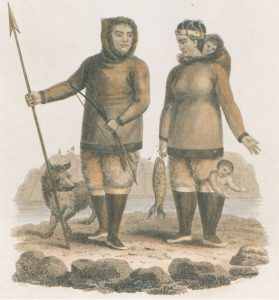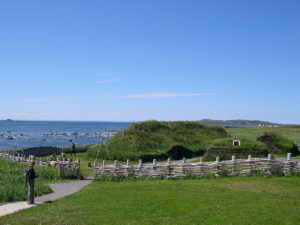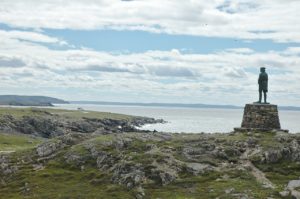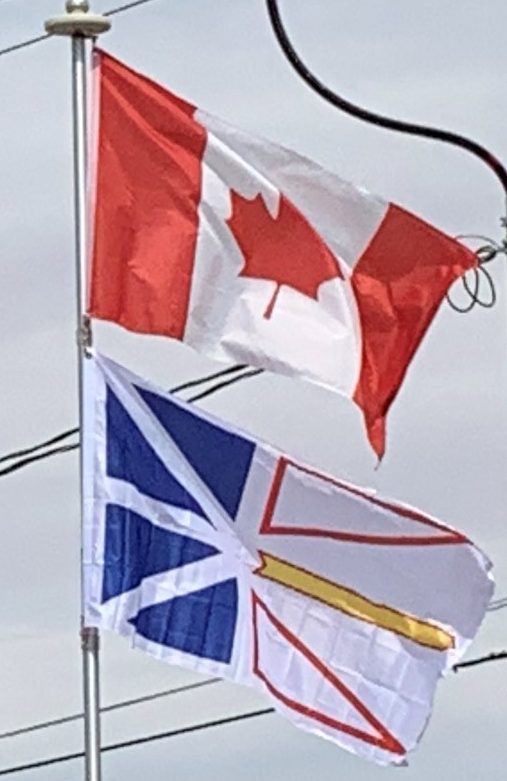
In the 18th century, as the Beothuk were driven further inland by these encroachments, violence between Beothuk and settlers escalated, with each retaliating against the other in their competition for resources. By the early 19th century, violence, starvation, and exposure to tuberculosis had decimated the Beothuk population, and they were extinct by 1829.
Geneticists have suggested some Icelanders may carry Beothuk DNA, which has been passed down matrilineally over the centuries. This suggests that when the Vikings abandoned their colonization of Newfoundland around 1000 AD, they might have brought back Beothuk women to Europe.
European Contact:
The oldest confirmed accounts of European contact date from a thousand years ago as described in the Viking (Norse) Icelandic Sagas. Around the year 1001, the sagas refer to Leif Ericson landing in three places to the west, the first two being Helluland (possibly Baffin Island) and Markland (possibly Labrador). Leif’s third landing was at a place he called Vinland (possibly Newfoundland). Archaeological evidence of a Norse settlement was found in L’Anse aux Meadows, Newfoundland, which was declared a World Heritage site by UNESCO in 1978.

There are several other unconfirmed accounts of European discovery and exploration, one tale by men from the Channel Islands being blown off course in the late 15th century into a strange land full of fish, and another from Portuguese maps that depict the Terra do Bacalhau, or land of codfish, west of the Azores. The earliest, though, is the Voyage of Saint Brendan, the fantastical account of an Irish monk who made a sea voyage in the early 6th century. While the story became a part of myth and legend, some historians believe it is based on fact.
In 1496 John Cabot obtained a charter from English King Henry VII to “sail to all parts, countries and seas of the East, the West and of the North, under our banner and ensign and to set up our banner on any new-found-land” and on 24 June 1497, landed in Cape Bonavista. Historians disagree on whether Cabot landed in Nova Scotia in 1497 or in Newfoundland, or possibly Maine, if he landed at all, but the governments of Canada and the United Kingdom recognize Bonavista as being Cabot’s “official” landing place. In 1499 and 1500, Portuguese mariners João Fernandes Lavrador and Pêro de Barcelos explored and mapped the coast, the former’s name appearing as “Labrador” on topographical maps of the period.

Based on the Treaty of Tordesillas, the Portuguese Crown claimed it had territorial rights in the area John Cabot visited in 1497 and 1498. Subsequently, in 1501 and 1502 the Corte-Real brothers, Miguel and Gaspar, explored Newfoundland and Labrador, claiming them as part of the Portuguese Empire. In 1506, King Manuel I of Portugal created taxes for the cod fisheries in Newfoundland waters. João Álvares Fagundes and Pêro de Barcelos established seasonal fishing outposts in Newfoundland and Nova Scotia around 1521, and older Portuguese settlements may have existed. Sir Humphrey Gilbert, provided with letters patent from Queen Elizabeth I, landed in St John’s in August 1583, and formally took possession of the island.
Colony of Newfoundland:
Sometime before 1563 Basque fishermen, who had been fishing cod shoals off Newfoundland’s coasts since the beginning of the sixteenth century, founded Plaisance (today Placentia), a seasonal haven which French fishermen later used. In the Newfoundland will, now in an archive in Spain, of the Basque seaman Domingo de Luca dated 1563, he asks “that my body be buried in this port of Plazençia in the place where those who die here are usually buried”. This will is the oldest known civil document written in Canada.
